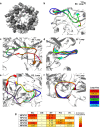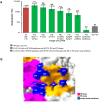The DE and FG loops of the HPV major capsid protein contribute to the epitopes of vaccine-induced cross-neutralising antibodies
- PMID: 28004837
- PMCID: PMC5177933
- DOI: 10.1038/srep39730
The DE and FG loops of the HPV major capsid protein contribute to the epitopes of vaccine-induced cross-neutralising antibodies
Abstract
The human papillomavirus (HPV) vaccines consist of major capsid protein (L1) virus-like particles (VLP) and are highly efficacious against the development of cervical cancer precursors attributable to oncogenic genotypes, HPV16 and HPV18. A degree of vaccine-induced cross-protection has also been demonstrated against genetically-related genotypes in the Alpha-7 (HPV18-like) and Alpha-9 (HPV16-like) species groups which is coincident with the detection of L1 cross-neutralising antibodies. In this study the L1 domains recognised by inter-genotype cross-neutralising antibodies were delineated. L1 crystallographic homology models predicted a degree of structural diversity between the L1 loops of HPV16 and the non-vaccine Alpha-9 genotypes. These structural predictions informed the design of chimeric pseudovirions with inter-genotype loop swaps which demonstrated that the L1 domains recognised by inter-genotype cross-neutralising antibodies comprise residues within the DE loop and the late region of the FG loop. These data contribute to our understanding of the L1 domains recognised by vaccine-induced cross-neutralising antibodies. Such specificities may play a critical role in vaccine-induced cross-protection.
Figures





Similar articles
-
Broad Cross-Protection Is Induced in Preclinical Models by a Human Papillomavirus Vaccine Composed of L1/L2 Chimeric Virus-Like Particles.J Virol. 2016 Jun 24;90(14):6314-25. doi: 10.1128/JVI.00449-16. Print 2016 Jul 15. J Virol. 2016. PMID: 27147749 Free PMC article.
-
A chimeric 18L1-45RG1 virus-like particle vaccine cross-protects against oncogenic alpha-7 human papillomavirus types.PLoS One. 2015 Mar 19;10(3):e0120152. doi: 10.1371/journal.pone.0120152. eCollection 2015. PLoS One. 2015. PMID: 25790098 Free PMC article.
-
Pre-clinical immunogenicity of human papillomavirus alpha-7 and alpha-9 major capsid proteins.Vaccine. 2014 Nov 12;32(48):6548-55. doi: 10.1016/j.vaccine.2014.07.116. Epub 2014 Sep 6. Vaccine. 2014. PMID: 25203446 Free PMC article.
-
Developments in L2-based human papillomavirus (HPV) vaccines.Virus Res. 2017 Mar 2;231:166-175. doi: 10.1016/j.virusres.2016.11.020. Epub 2016 Nov 23. Virus Res. 2017. PMID: 27889616 Free PMC article. Review.
-
Worldwide genetic variations in high-risk human papillomaviruses capsid L1 gene and their impact on vaccine efficiency.Gene. 2021 May 25;782:145533. doi: 10.1016/j.gene.2021.145533. Epub 2021 Feb 23. Gene. 2021. PMID: 33636291 Review.
Cited by
-
Differential long-term bivalent HPV vaccine cross-protection by variants in the Costa Rica HPV vaccine trial.NPJ Vaccines. 2024 Jun 8;9(1):101. doi: 10.1038/s41541-024-00896-y. NPJ Vaccines. 2024. PMID: 38851816 Free PMC article.
-
Naturally occurring capsid protein variants L1 of human papillomavirus genotype 16 in Morocco.Bioinformation. 2017 Aug 31;13(8):241-248. doi: 10.6026/97320630013241. eCollection 2017. Bioinformation. 2017. PMID: 28959092 Free PMC article.
-
Expression of different L1 isoforms of Mastomys natalensis papillomavirus as mechanism to circumvent adaptive immunity.Elife. 2020 Aug 4;9:e57626. doi: 10.7554/eLife.57626. Elife. 2020. PMID: 32746966 Free PMC article.
-
Critical Residues Involved in the Coassembly of L1 and L2 Capsid Proteins of Human Papillomavirus 16.J Virol. 2023 Mar 30;97(3):e0181922. doi: 10.1128/jvi.01819-22. Epub 2023 Feb 23. J Virol. 2023. PMID: 36815785 Free PMC article.
-
Short Disordered Epitope of CRTAM Ig-Like V Domain as a Potential Target for Blocking Antibodies.Int J Mol Sci. 2020 Nov 20;21(22):8798. doi: 10.3390/ijms21228798. Int J Mol Sci. 2020. PMID: 33233764 Free PMC article.
References
-
- de Martel C. et al.. Global burden of cancers attributable to infections in 2008: a review and synthetic analysis. The Lancet. Oncology 13, 607–615 (2012). - PubMed
-
- Forman D. et al.. Global burden of human papillomavirus and related diseases. Vaccine 30 Suppl 5, F12–23 (2012). - PubMed
-
- Li N., Franceschi S., Howell-Jones R., Snijders P. J. & Clifford G. M. Human papillomavirus type distribution in 30,848 invasive cervical cancers worldwide: Variation by geographical region, histological type and year of publication. International journal of cancer 128, 927–935 (2010). - PubMed
Publication types
MeSH terms
Substances
LinkOut - more resources
Full Text Sources
Other Literature Sources
Molecular Biology Databases

